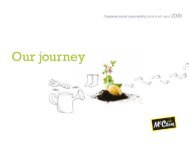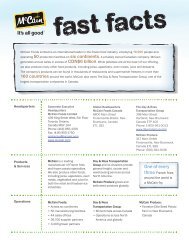From the Ground Up - McCain Foods Limited
From the Ground Up - McCain Foods Limited
From the Ground Up - McCain Foods Limited
Create successful ePaper yourself
Turn your PDF publications into a flip-book with our unique Google optimized e-Paper software.
Opening of <strong>the</strong> Lelystad<br />
plant, 1997: Harrison; Folkert<br />
Sneep, managing director for<br />
nor<strong>the</strong>rn Europe; and Howard<br />
Mann, president and CEO,<br />
<strong>McCain</strong> <strong>Foods</strong> <strong>Limited</strong>.<br />
focused his attention. “There are more people and more<br />
money in Germany, and <strong>the</strong> Germans pay more for quality<br />
than <strong>the</strong> Dutch,” says Van der Wel. As well, German consumers<br />
prefer to prepare <strong>the</strong>ir french fries in <strong>the</strong> oven.<br />
“The value-added is higher in oven fries than in regular<br />
ones,” says Van der Wel. “They are more difficult to<br />
produce, so competitors can’t copy you as readily, and<br />
you have a competitive advantage, which you can market<br />
in an advertising campaign, building yourself a strong<br />
market position. In <strong>the</strong> Ne<strong>the</strong>rlands, we could not do that<br />
because <strong>the</strong>re was not <strong>the</strong> money to advertise, and <strong>the</strong> demand<br />
for oven fries was much lower than in Germany.”<br />
To become intimately acquainted with <strong>the</strong> German market, Van der Wel spent six<br />
weeks <strong>the</strong>re, travelling with each of <strong>McCain</strong>’s German salespersons. This allowed him<br />
to see stores and restaurants, to meet customers, and to evaluate <strong>the</strong> strengths of <strong>the</strong><br />
sales force. After that, he went to Germany every o<strong>the</strong>r week.<br />
In 1983, Van der Wel became CEO for <strong>McCain</strong> <strong>Foods</strong> for Europe, including France,<br />
which had been under separate management before. At <strong>the</strong> same time, Tony van<br />
Leersum moved to Florenceville to take on responsibility for corporate development<br />
in Europe and <strong>the</strong> Middle East. He also served as McDonald’s international account<br />
manager.<br />
The following years were a time of rapid growth for <strong>McCain</strong> in Europe, with sales<br />
over a ten-year period ballooning from $70 million to $450 million. The growth was<br />
<strong>the</strong> result of increasing <strong>the</strong> market for french fries, introducing many new products,<br />
and acquiring new businesses. These included a frozen food company, Frima, with<br />
production facilities in Ostend and Grobbendonk, Belgium, which became <strong>McCain</strong><br />
Frima NV; and Beaumarais, a fries and potato-flake manufacturer in Bethune, France,<br />
near Harnes. In 1988, <strong>McCain</strong> spent $33 million to double production at Harnes.<br />
And in 1991, <strong>McCain</strong> picked up its fourth french fry plant in <strong>the</strong> Ne<strong>the</strong>rlands, in <strong>the</strong><br />
town of Lelystad.<br />
Van der Wel cites several reasons for <strong>McCain</strong>’s rapid growth. For one, <strong>the</strong> senior<br />
management team collaborated well and were all committed to rapid expansion.<br />
Van der Wel has worked at several major food companies but at <strong>McCain</strong> he experienced<br />
“by far <strong>the</strong> best teamwork I ever had in my career.” Also, <strong>McCain</strong> was<br />
entering big markets – Germany, France, and Italy – that were underdeveloped in<br />
processed potatoes.<br />
A strategic decision by Harrison and Wallace was ano<strong>the</strong>r important factor. They<br />
differentiated <strong>McCain</strong> from competing companies by strongly supporting <strong>the</strong>ir own<br />
brand ra<strong>the</strong>r than private labels. “That requires heavy investments in marketing,<br />
which reduced short-term profitability, but it was an excellent long-term decision<br />
because it is now very profitable,” says Van der Wel. “We were marketers. The competition<br />
were merchandisers.”<br />
Sometimes, however, marketing doesn’t work <strong>the</strong> way it’s supposed to. The selling<br />
point of oven fries is that <strong>the</strong>y have less fat and less odour than <strong>the</strong>ir fried counterparts.<br />
In <strong>the</strong> early 1980s, an advertising agency came up with a French TV commercial<br />
that showed a poodle coming into <strong>the</strong> kitchen while fries were being prepared. The<br />
dog has its tail in <strong>the</strong> air when fries are in <strong>the</strong> oven, but when <strong>the</strong> dog comes back into<br />
<strong>the</strong> kitchen and <strong>the</strong> fryer is going, he runs away in disgust.<br />
“It got <strong>the</strong> prize for <strong>the</strong> least effective commercial in Europe,” says Van der Wel. “You<br />
don’t identify human food with dogs. It was humorous, but it didn’t work at all. And<br />
it was premature for France because <strong>the</strong> French weren’t interested in oven fries.” The<br />
advertising agency and marketing director were both fired. “We lost a lot of money.<br />
<strong>McCain</strong> was down <strong>the</strong> drain. We couldn’t get listings, we couldn’t get distribution. Later,<br />
we changed our whole approach to fried french fries in France.”<br />
Ano<strong>the</strong>r miscue occurred in Germany with a new product, onion-flavoured hash<br />
browns called Rösti Ecken. The art on <strong>the</strong> package showed six triangular potato pieces.<br />
But <strong>the</strong> equipment in <strong>the</strong> plant making <strong>the</strong>m couldn’t be relied on to produce six per<br />
package. Although <strong>the</strong> total weight of <strong>the</strong> package contents was accurate, sometimes<br />
<strong>the</strong>re were seven pieces instead of six. “The Germans are meticulous,” says Van der Wel.<br />
“They want what is inside to be <strong>the</strong> same as what is shown on <strong>the</strong> bag. If <strong>the</strong> bag shows<br />
84 <strong>From</strong> <strong>the</strong> <strong>Ground</strong> up<br />
Across <strong>the</strong> chA nnel 85<br />
LEFT: The 1984 fire at <strong>the</strong><br />
Lewedorp factory reduced<br />
<strong>the</strong> building to a burnt-out<br />
shell. The ground is littered<br />
with potatoes.<br />
RIGHT: Jan van der Neut-<br />
Kolfschoten, chief engineer,<br />
Europe; Paul van der Wel; and<br />
Harrison at <strong>the</strong> site of <strong>the</strong> fire.






